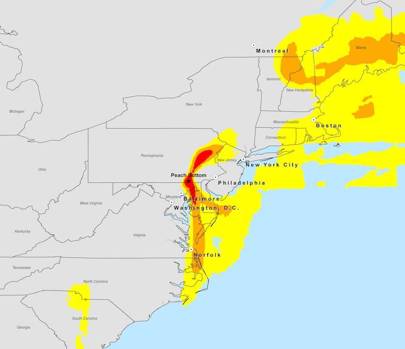27 May, 2017
The NRC also said that the consequences would be dealt with within a year, while the Chernobyl and Fukushima accidents have shown much worse effects, with the areas still deserted.
Researchers from Princeton University and the Union of Concerned Scientists (UCS) argued that the NRC "relied on faulty analysis to justify its refusal to adopt a critical measure for protecting Americans from the occurrence of a catastrophic nuclear-waste fire at any one of dozens of reactor sites around the country".
An accident at Japan's Fukushima nuclear plant in 2011 was triggered by a tsunami after an quake. My Princeton University co-authors have calculated, using sophisticated computer models, that a spent fuel pool fire at the Peach Bottom nuclear plant in Pennsylvania could heavily contaminate over 30,000 square miles with long-lived radioactivity and require the long-term relocation of almost 20 million people, for average weather conditions.
The reluctance of USA federal regulators to require operators of nuclear reactors to spend $5 billion to enhance the security of spent fuel rods stored underground threatens the country with a potential catastrophe, scientists warned on Friday. This has greatly increased the risk to the public should a large natural disaster or terrorist attack breach the liner of a spent fuel pool, causing the pool to rapidly lose its cooling water.
The researches further pointed out that a nuclear disaster could be brought about by a large quake or terrorist attack, the possibility of which was excluded by the NRC.
By failing to account for an act of terrorism or a fire in the spent-fuel pools, the commission completely underestimated the potential dangers related to proceeding without dry casks, the study says.
'Unfortunately, if there is no public outcry about this unsafe situation, the NRC will continue to bend to the industry's wishes, ' he concluded. Michael Schoeppner and Frank von Hippel of Princeton University were co-authors.
At first, the authors of the study note, the accident would have mostly affected a small part of Pennsylvania State and its major city of Philadelphia, barely reaching neighboring states of New York, Massachusetts and CT. The projection is based on actual weather patterns that occurred in April 2015.
Spent-fuel pools were brought into the spotlight following the March 2011 nuclear disaster in Fukushima, Japan.
The end result of the Fukushima incident, in which a 9.0 magnitude quake triggered a tsunami that disabled cooling systems necessary to maintain reactor cores, would have been much worse if the pools had been damaged, the researcher said, pushing Congress to pass a regulation on the matter since the NRC had declined to do so. "That nearly happened at Fukushima in Unit 4".
Scientists are confident that the catastrophe can be avoided if the commission applies necessary regulatory measures to nuclear power plants. Instead, they add, it would be safer to transfer it to dry storage casks after it is cooled in pools for around five years. The fuel remains onsite in water-filled pools, but if the water was removed or suddenly evaporated it's possible the fuel could catch fire, spreading radioactive material.
During its "top-to-bottom" review, prompted by the Fukushima disaster, the NRC found that the potential damage from a reactor fire would be about $125 billion, and that the consequences would be limited to within a 50-mile radius. However, the agency decided the possibility of such a fire is so unlikely that it could not justify requiring plant owners to pay the estimated cost of $50 million per pool.
The disaster would lead to "trillion-dollar consequences", as the hypothetical fire would result in contamination of an area larger than New Jersey and force mass relocations. It also assumed that all contaminated areas could be effectively cleaned up within a year. This doesn't match up with the reality experienced at Fukushima and following the 1986 Chernobyl disaster, says the report. In this scenario, which is based on real weather patterns that occurred in July 2015, four major cities would be contaminated (New York City, Philadelphia, Baltimore and Washington, D.C.), resulting in the displacement of millions of people. They found that millions of residents in surrounding communities would have to relocate for years, resulting in total damages of $2 trillion-nearly 20 times the NRC's result. Not that the difference matters that much to the nuclear industry: As the physicists point out, the USA government passed a law in 1957 that caps what the industry would have to pay in event of an accident at just $13.6 billion.
They have called on the agency to take action to reduce the potential danger by enhancing the monitoring of the pools and increasing water levels in case of a breakdown.
"We think the NRC gamed their analysis essentially to get the answer they want", said Edwin Lyman, a senior scientist at the Union of Concerned Scientists and one of the authors of the article in "Science", a magazine published by the American Association for the Advancement of Science. "It is time for the NRC to employ sound science and common-sense policy judgments in its decision-making process", he said.
The scientists simulated a nightmare scenario in their "Nuclear safety regulation in the post-Fukushima era" article.






